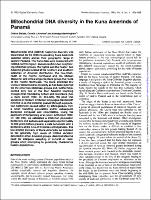Mitochondrial DNA diversity in the Kuna Amerinds of Panama

View/
Date
1995Author
Batista, Oriana
Kolman, Connie J.
Bermingham, Eldredge
Metadata
Show full item recordAbstract
Mitochondrial DNA (mtDNA) haplotype diversity was determined for 63 Chlbcha-speaking Kuna Amerinds
sampled widely across their geographic range in eastern Panama^ The Kuna data were compared with
mtDNA control region I sequences from two neighboring Chibchan groups, the Ngdb6 and the Huetar; two
Amerind groups located at the northern and southern extremes of Amerind distribution, the Nuu-ChahNulth of the Pacific Northwest and the Chilean Mapuche; and with a single Na-Dene group, the Haida of the Pacific Northwest. The Kuna exhibited low levels of mitochondrial diversity as had been reported for the other two Chibchan groups and, furthermore,
carried only two of the four Amerind founding lineages first reported by Schurr and coworkers (4m. J. Hum. Genet. 1990; 46: 613-623). We posit that speakers of modern Chibchan languages (henceforth referred to as the Chibcha) passed through a population bottleneck caused either by ethnogenesls from a small founding population and/or subsequent European conquest and colonization. Using the approach of Harpending etal. (Curr. Anthropol. 1993; 34: 483-496), we estimated a Chibchan population
bottleneck and subsequent expansion approximately 10 000 years before present, a date consistent with a bottleneck at the time of Chibchan ethnogenesis. The low mtDNA diversity of Kuna Amerinds, as opposed to the generally high levels of mtDNA variation detected in other Amerind groups, demonstrates the need for adequate sampling of cultural or racial groups when attempting to genetically characterize human populations.
